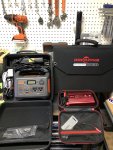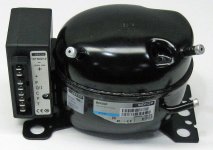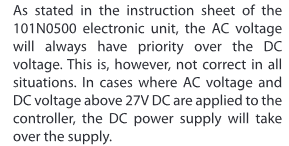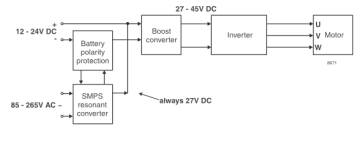You are using an out of date browser. It may not display this or other websites correctly.
You should upgrade or use an alternative browser.
You should upgrade or use an alternative browser.
Jackery 1000 vs dual battery vehicle set up for running ARB fridge.
- Thread starter zimm17
- Start date
I keep a ARB 50QT in the back of my Jeep. After getting stranded with a dead battery once, I don't trust the voltage cut off to leave the fridge running while out camping with the single battery.
Option 1: Genesis dual battery kit, which will cost $600 plus 2 new batteries, another $680 for matching group 34 Odyssey's. https://www.genesisoffroad.com/jk-dual-battery-kit
Option 2: Get a lithium portable to keep the fridge plugged into and have it charged via the vehicle while on the road/trail - A Jackery 1000 is about $1000.
What makes the most sense for off-road/camping trips? I'm typically driving most of the day so it's very rare the fridge has to run 2 days without the engine running.
If Option 2 is the winner, what's the consensus of wiring in a big inverter to charge it on AC vs. using large gauge DC wiring to it from the battery?
Another benefit of the portable is it can charge devices while camping much easier than leaving the iPad/iPhone in the Jeep. Also I could move the portable plus the fridge over to another vehicle easier. But I don't know much about these Jackery things.
I did option 2.
The ARB is dual input, and it favors AC. So I plug the ARB into the AC outlet in my vehicle, which cuts off when vehicle is off. I plug Goal Zero into ARB/DC, so it takes over when vehicle is off. I also plug Goal Zero in 12VDC of car, which allows it to recharge when vehicle is on.
If vehicle did not have AC, I would just do DC and skip the inverter.
SFP
Member
my home made 100ahr lifepo4 jackery! charges fr truck and/solar, usb, barrel plugs, cig outlet and anderson for refrigerator. just as portable. fraction of the cost.
great details and info on jasonoid's youtube channel.
View attachment 707122View attachment 707123View attachment 707124
That is the **************** brilliant - Thank so much for sharing. Will definitely be building one of these this spring.
Last edited:
ThundahBeagle
Well-known member
A dual battery setup is really only ideal as an emergency backup *starter* battery - in which case the secondary battery should be a *starter* battery, matched to the primary. If you are running accessories from the secondary you kind of lose the "emergency backup" part of the deal.
Stick with a portable setup for running accessories, for all of the reasons you mentioned. You'll probably get the best results charging the portable unit directly from the vehicle battery, but as has been mentioned, the wires will need to be large. Buy once, cry once.
Uh, does this go for internally mounted comms and external mounted auxiliary and camp lights, in your view?
OllieChristopher
Well-known member
I'm using both my Jackery 300 solar generator and dual battery setup for keeping my cooler and other accessories powered up. My cheap BougeRV 30 quart cooler set at 37 degrees will run off my 300 Jackery for almost 24hrs in over 100 degree desert heat. If I plug in my solar panel it will stay charged and keep cooler going indefinitely.
Another cool "quick charge" trick I found that works with any of the Jackery solar generator lineup is to use an Inverter and USB C plugged into your vehicle instead of the cig charger when driving. My 300 solar generator can charge from 0% to 100% in under 4hrs.

Another cool "quick charge" trick I found that works with any of the Jackery solar generator lineup is to use an Inverter and USB C plugged into your vehicle instead of the cig charger when driving. My 300 solar generator can charge from 0% to 100% in under 4hrs.

4000lbsOfGoat
Well-known member
OPs use case was specifically for running a fridge - i.e. relatively high draw while the vehicle is not running. Also, the fridge is only used occasionally. I think a portable unit is the better solution for that use case.Uh, does this go for internally mounted comms and external mounted auxiliary and camp lights, in your view?
Internally mounted comms are typically going to be operated while the vehicle is running - so no battery drain issues. Camp lighting is very low draw compared to a fridge. I personally do run aux\camp lighting from my secondary battery but I also monitor the battery constantly and have the means to recharge it via solar if necessary (i.e. when I'm stationary for a few days or more). I was trying to steer OP in the simplest direction - I live full-time out of my rig so my rig is rather complex. Not everyone needs to get into that level of complexity.
Yes, in my "ideal" world I wouldn't run anything at all from the "secondary starting" battery but at some point you run out of space to mount more batteries in a Tacoma...On a long-duration trip (not OPs use case) battery monitoring and maintenance is kind of the primary task for each day anyway.
Cheers!
Kevin108
Explorer
I'm interested. Please link some examples.Many more and better power stations than the Jackery brand are now available.
zimm17
Observer
I've been researching more since I first posted the original question. The Bluetti A200max is a heavy and expensive beast, but one of the very few to use a LiFePO4 battery which lasts for thousands of charges and possibly a decade or more, compared to a Jackery that can only do a few hundred charges and degrades in just a few years. https://www.bluettipower.com/products/ac200max-power-station
Or I might try and build one myself.
Or I might try and build one myself.
zimm17
Observer
The ARB is dual input, and it favors AC.
Isn't the Danfoss compressor in the ARB DC powered? I would think it favors direct DC input rather than running an inverter, feeding it AC power, the fridge then uses a converter to change it back to 12VDC.
eddie_yeti
New member
I have an old dual-isolated battery setup w/ solar. Can I run a 12v line from that setup to plug into the Jackery to charge it? I don't want to remove the entire dual battery setup, and would like the option of adding a larger, modern and removable power source such as a Jackery.
DaveInDenver
Middle Income Semi-Redneck
How those Secop/Danfoss controllers work for sure is not something I've ever figured out. They're pretty tight-lipped about service manuals via web searches. I've got some design experience in similar products so it's not esoteric per se but I've just never seen schematics nor have had one to reverse engineer.Isn't the Danfoss compressor in the ARB DC powered? I would think it favors direct DC input rather than running an inverter, feeding it AC power, the fridge then uses a converter to change it back to 12VDC.
In any case, some of them seem to accept DC only and a separate AC/DC supply is installed in the fridge case while other model controllers are capable of being given both DC and AC directly.
Like this combo has connections for mains line and neutral directly.

While this one does not.

In any case the compressor motor itself is AC, maybe low voltage but perhaps not. I've also seen reference that the Secop motors are 3-phase. That would be some of their internal documentation that I've never come across publicly and I don't have one to tear apart to figure out.
Secop suggests DC is preferred if it can but I assume that is only in the sense that an OR decision has to be made and DC will always be present in a portable fridge. But with less than 27VDC on the battery it'll pick AC if present. Obviously the high voltage AC option is run into a converter to make 27VDC anyway so there's no efficiency gain running on the mains but there is loss in the boost stage potentially.


Last edited:
Herbie
Rendezvous Conspirator
It's important to note that when fridge manufacturer calls out which input is "preferred", what they really mean is just which input to the controller going to be selected by the controller to drive the compressor. This does NOT imply that one input is more efficient than the other.
There are design considerations as to why you might make the controller always pick AC when available. For example, it's reasonable to assume that the fridge might be hard-wired to DC, and that AC would be maybe there, maybe not. It's much more convenient for the customer to be able to leave the DC input connected and just choose the AC when it's available (so as not to continue to use the house battery). You would most likely do this even if AC is less efficient, because on AC you don't really care about peak efficiency, as it sort of implies you're on mains supply.
In the case of DaveInDenver's diagram above, it's plain to see that the AC input is first converted to 27VDC via switched mode power supply, then boosted and inverted back to the low-voltage AC. This is certainly NOT as efficient as taking straight DC voltage and just running it into the boost/inverter circuit. (Switched mode power supplies typically are about 85% efficient.) The side note about DC inputs >27V taking over aren't really for a normal use case as that's a very odd voltage, it just means that in that case you'd by bypassing the boost converter and feeding the raw DC straight to the inverter.
Given the additional inefficiency of a DC powered inverter (again, around 85%-90% transmission), you would expect to lose about 30% of your battery power to heat if you went DC->Inverter->AC->Fridge vs just DC->Fridge.
There are design considerations as to why you might make the controller always pick AC when available. For example, it's reasonable to assume that the fridge might be hard-wired to DC, and that AC would be maybe there, maybe not. It's much more convenient for the customer to be able to leave the DC input connected and just choose the AC when it's available (so as not to continue to use the house battery). You would most likely do this even if AC is less efficient, because on AC you don't really care about peak efficiency, as it sort of implies you're on mains supply.
In the case of DaveInDenver's diagram above, it's plain to see that the AC input is first converted to 27VDC via switched mode power supply, then boosted and inverted back to the low-voltage AC. This is certainly NOT as efficient as taking straight DC voltage and just running it into the boost/inverter circuit. (Switched mode power supplies typically are about 85% efficient.) The side note about DC inputs >27V taking over aren't really for a normal use case as that's a very odd voltage, it just means that in that case you'd by bypassing the boost converter and feeding the raw DC straight to the inverter.
Given the additional inefficiency of a DC powered inverter (again, around 85%-90% transmission), you would expect to lose about 30% of your battery power to heat if you went DC->Inverter->AC->Fridge vs just DC->Fridge.
Herbie
Rendezvous Conspirator
All of my above math aside, the reason I tend to choose hard-wired house battery systems vs. a portable system is hassle factor.
I completely hate having to spend any mental energy dealing with any of my camping systems while I'm out camping. I want the system to always be charged and ready to go when I leave, and for everything to stay happy while I camp. A big house battery with a big solar panel and all the loads hard-wired means my total "mental load" is that I check the state of the battery voltage about once every day or two on the trip. As a matter of habit, I plug my RV into shore power with one external plug when I park it in my driveway, but I think with my current panel, that's probably not even required except if I'm pre-chilling the fridge.
If I had a system that required that I (a) manage the pre-charging of a battery before the trip, or (b) manage plugging/unplugging some or all of it while on a trip, I would be less happy, overall.
I completely hate having to spend any mental energy dealing with any of my camping systems while I'm out camping. I want the system to always be charged and ready to go when I leave, and for everything to stay happy while I camp. A big house battery with a big solar panel and all the loads hard-wired means my total "mental load" is that I check the state of the battery voltage about once every day or two on the trip. As a matter of habit, I plug my RV into shore power with one external plug when I park it in my driveway, but I think with my current panel, that's probably not even required except if I'm pre-chilling the fridge.
If I had a system that required that I (a) manage the pre-charging of a battery before the trip, or (b) manage plugging/unplugging some or all of it while on a trip, I would be less happy, overall.
DaveInDenver
Middle Income Semi-Redneck
@Herbie, greater than 27V input I think came from a nominal 24V controller document so the assumption is simply that the engine is running and charging. I don't know for a fact that all Secop/Danfoss/etc work this way or use these same values.
Clearly the Secop design intent in this case is to maximize efficiency for the DC path and above 27V they can just bypass straight to the inverter input, up to 45V apparently anyway. That's just going to incur a small FET switch loss rather than letting the converter freewheel or start regulating down. It's not a lot of lost energy but it's not zero either. It's probably a 1%-2% efficiency improvement.
Your assumption for controller preference for AC below this point is probably spot-on. It's not that the designer can necessarily ignore efficiency from the mains but it's a relatively lower limit well you have to worry about. If you have AC and the engine is not running (e.g. lower than 27V) no reason to put any load on the local batteries.
There's external concerns with ground and neutral isolation that would factor in but a simple offline SMPS (the inside of the controller converter) could be on the order of low 90% efficiency so it might not be a tremendous hit to run through a second inverter (outside the fridge).
This is kind of a system design question ultimately. The fridge designer has to assume things but if you're on a fairly significant solar system a higher loss of ~10% double inverting might be tolerable in your scheme if it reduces wiring or operational complexity.
I doubt any fridge is going to be any different, the DC (battery assumed) path being the most efficient, though.
One thing is I do seem to recall that Engel uses a transformer in their controller (the DC in this case feeds an inverter and the selection would be later in the circuit between two AC sources) so theirs might not follow the same set of assumptions. I have an MT45 and to my non-musical but I think trained to hear oddities ear the compressor sounds smoother on mains and has a slight periodic stumble in it's sound on DC, which is perhaps a byproduct of the inverter. That could mean there's no efficient hit on AC for it.
Clearly the Secop design intent in this case is to maximize efficiency for the DC path and above 27V they can just bypass straight to the inverter input, up to 45V apparently anyway. That's just going to incur a small FET switch loss rather than letting the converter freewheel or start regulating down. It's not a lot of lost energy but it's not zero either. It's probably a 1%-2% efficiency improvement.
Your assumption for controller preference for AC below this point is probably spot-on. It's not that the designer can necessarily ignore efficiency from the mains but it's a relatively lower limit well you have to worry about. If you have AC and the engine is not running (e.g. lower than 27V) no reason to put any load on the local batteries.
There's external concerns with ground and neutral isolation that would factor in but a simple offline SMPS (the inside of the controller converter) could be on the order of low 90% efficiency so it might not be a tremendous hit to run through a second inverter (outside the fridge).
This is kind of a system design question ultimately. The fridge designer has to assume things but if you're on a fairly significant solar system a higher loss of ~10% double inverting might be tolerable in your scheme if it reduces wiring or operational complexity.
I doubt any fridge is going to be any different, the DC (battery assumed) path being the most efficient, though.
One thing is I do seem to recall that Engel uses a transformer in their controller (the DC in this case feeds an inverter and the selection would be later in the circuit between two AC sources) so theirs might not follow the same set of assumptions. I have an MT45 and to my non-musical but I think trained to hear oddities ear the compressor sounds smoother on mains and has a slight periodic stumble in it's sound on DC, which is perhaps a byproduct of the inverter. That could mean there's no efficient hit on AC for it.
Last edited:
Similar threads
- Replies
- 7
- Views
- 877
- Replies
- 5
- Views
- 1K
- Replies
- 2
- Views
- 1K
- Replies
- 6
- Views
- 2K
- Replies
- 15
- Views
- 4K



